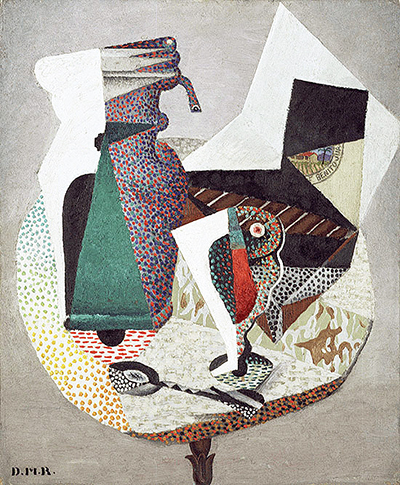Within Cafe Terrace from 1915, Diego Rivera would combine a Cubist style with touches of Pointilism which helped to draw out certain details within the work. What we have here is a delightfully crafted piece which can be considered one of the artist's best in this genre.
Cubist artists would often feature tables laden with food and drink and this inspired Rivera to produce similar himself. Within this painting we find a slim table top with stand pointing downwards, and several items of note placed upon it, including a green bottle, a metallic spoon, and a glass. There is also a patterned table cloth which adds plenty to the scene itself. Some have argued that the green bottle represents absinthe, and that the remaining objects upon the table are for the preparation of a toxic and famous drink which was particularly popular in Paris at the time. It is Rivera's time living in the city which specifically inspired his entry into Cubism and he would produce a good amount of work within this contemporary approach over the period of several years. He came across a number of other interesting creative individuals during this time including Picasso, Mondrian and Modigliani and they would all exchange their own ideas with each other, sharing a mutual respect and interest in each other's work.
Within this painting there are references which most would be entirely unaware of, partly because of how they are disguised within the Cubist manner, but also in how some of the connections are fairly obscure to the western eye. For example, there is a cigar box featuring a label that refers to a former President of Mexico from the 19th century and the use of camouflage across the tablecloth is likely to have been a connection to WWI which had commenced just a year earlier, and with Rivera living in France at the time, it would have greatily impacted his own life. The use of absinthe is also a particularly strong cultural symbol too, because of how it became an integral part of cafe culture within Paris at around this time until eventually being banned because of how it impacted many who drank it. This prohibition if anything gave it something of an iconic status and attracted more to try it.
Rivera was one of the few artists who managed to fuse two very different cultures together within his work. He never lost his love for Mexican culture and its people, but was too ambitious and curious an artist to limit himself just to one country. Over time he would learn much from the creative side of Europe and the US, but it must be remembered that he also gave plenty of influence in the opposing direction as well. Artists would often work collaboratively and even the most successful painters would not be too arrogant as to dismiss ideas from others that they respected. Rivera himself was an extrovert character who tended to receive respect fairly soon and so was able to forge close friendships with a number of high profile artists over his lifetime. This fusion would become the secret of his success, as he learned how to impress different audiences and ultimately win some highly prized commissions.




